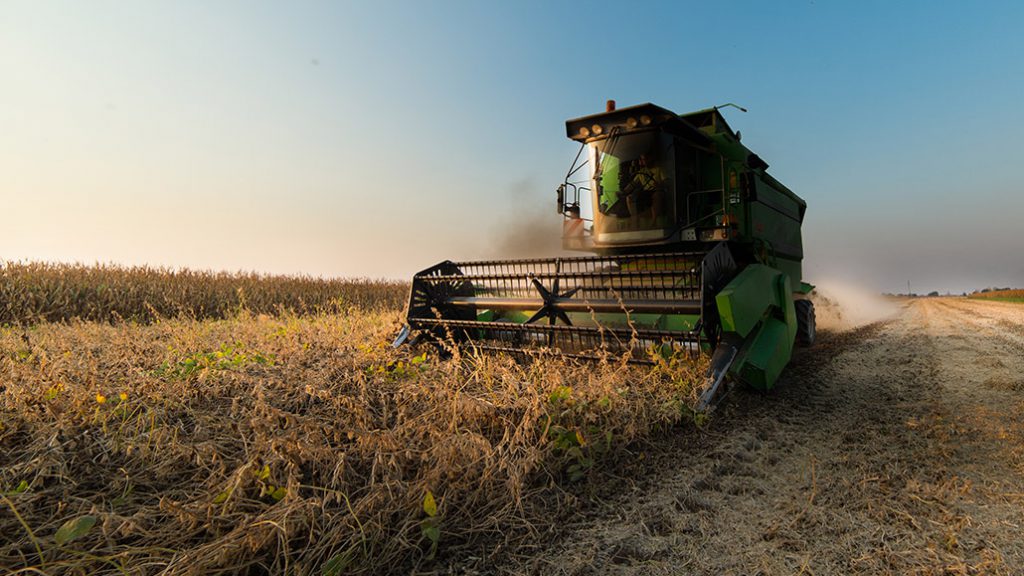Soybean harvest
STRATEGIES TO MAINTAIN QUALITY

WHEN PREPPING AND carrying out this year’s soybean harvest, experts say careful attention should be paid to the setup of machinery — as well as wider agronomic issues and planning.
SPEED KILLS SOYBEAN YIELDS
Machinery setup can have a direct impact on soybean quality during harvest, say both Horst Bohner, soybean specialist with the Ontario Ministry of Agriculture, Food and Rural Affairs, and Russ Barker, a Pioneer Hybrid sales representative and certified crop adviser based near St. Marys.
“Getting beans into the combine is what it’s all about,” says Bohner, though what proportion actually makes it to the hopper — and what is damaged or left in the field along the way — can vary substantially based on things such as header height and speed.
According to Barker, overzealous or untrained operators, in particular, can help even the best harvest systems fail.
“You can pick the colour, but they all will do a very good job in the hands of a skilled operator. They all will make a mess in the hands of someone that does not pay attention,” he says. “Speed is particularly an enemy in clipping soybeans, even with very well-maintained equipment, just from leaving beans on the ground, pushing them over, and scattering.”
However, speed relates to combine parts as well as forward momentum. Michael Stanton, soybean educator and researcher with Michigan State University, says field research indicates more losses occur from overly-quick reel activity than anything else.
Like Bohner, Stanton affirms reel height and forward position can be equally culpable.
“It’s a major cause of shatter losses. Pushing it too far in front fails to pick beans up,” he says. “If the beans are hitting the windshield, that’s a sign things are running too fast.”
ESTIMATING AND PREVENTING FRONT-END LOSSES
According to Stanton, front-end issues cause the bulk of harvest losses in soybeans — as much as 90 per cent, though 80 per cent of losses is more commonly cited. Farmers, he says, can garner a quick estimate of potential losses by harvesting a small area, reversing the combine, and counting the number of plants still standing in small sample plots.
“The rule of thumb is four [standing] beans per square foot equals one bushel per acre loss. It’s really easy to count,” says Stanton.
“Losses typically are one to two bushels on average. They’re not huge numbers, but when you get into short beans or green stem syndrome, different scenarios, they can go up really fast. If we’re not paying attention it can be a real problem.”
Aside from proper machinery operation, Stanton says preventing losses starts with preventative combine maintenance — ensuring guards are aligned, components are tightly fixed, knives are sharp, and so on.
The next involves harvesting before moisture levels drop too low.
“We’re actually encouraging producers to get into the field when the beans are at 15 per cent. Try and get in there sooner than later,” says Stanton, later adding technologies like air-assisted reels can help in very dry conditions.
Losses from rear or internal combine components, while less substantial, are harder to measure. Such losses primarily manifest when crop volume is high enough to reduce the effectiveness of internal components (e.g. thrashers), though draper headers and other technologies can help mitigate the risk.
“You can put more material through the draper head,” Stanton says.
HARVESTING EARLY SUPPORTS WIDER AGRONOMIC GOALS
Bohner also says harvesting earlier — and potentially paying a little extra for drying — has benefits.
“I do wonder if we should get them at a little higher moisture in order to get winter wheat in. Sometimes I think we could do ourselves a favour by putting on a pre-harvest burndown. It doesn’t dry things much, but it removes weeds and makes it ready for wheat seeding.”
Longer-term management can be similarly supported, when conditions permit, by planting earlier in the spring — as well as using varieties well-suited to localized conditions. Understanding one’s own tolerances for field and weather conditions, too, is always a factor.
“There are advantages like more yield typically, and we can get them off earlier. That’s one of the reasons why, in modern production, we talk about planting early,” says Bohner.
“We certainly don’t want to see ruts, but we all know that’s sometimes the way it turns out.”
KEEP AN EYE ON NEMATODES AND WHITE MOULD
White mould can be another major problem pre-harvest, and one for which Barker encourages growers to be very vigilant — particularly those in areas where the pathogen is more prolific. But responding to it can be challenging since fungicides are generally not as effective in soybeans as in corn.
“Fungicides can work. It just doesn’t seem to give the same bang as in corn,” says Barker. “For folks that have [mould], it’s a significant issue and needs to be dealt with.”
He adds keeping careful stock of nematode populations should also be a year-round activity. Doing so better supports long-term agronomy decisions, such as how nematode-resistant the next planted variety should be.
“It can take you from 50 to 35 bushel in the blink of an eye. It’s one that will kill you on soybeans,” he says. •


























